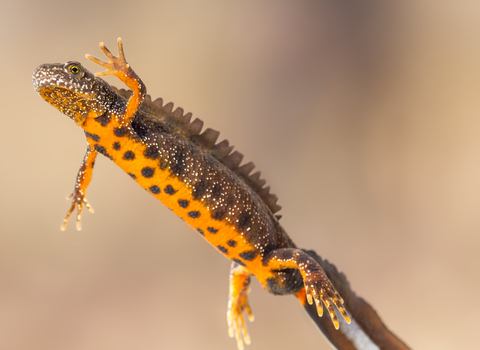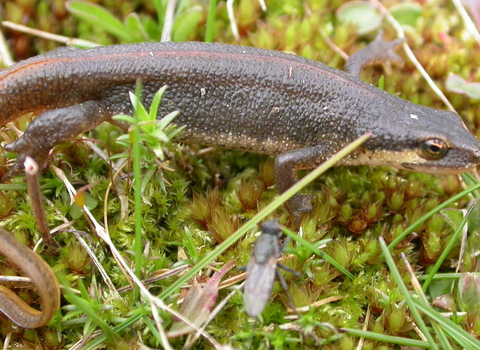Newts are amphibians, breeding in ponds during the spring and spending most of the rest of the year feeding on invertebrates in woodland, hedgerows, marshes and tussocky grassland. They hibernate underground, among tree roots and in old walls.
Know your newts
(c) Kevin Caster

Great crested newt
Great crested newt
Our biggest newt, the great crested newt is almost black in colour, with spotted flanks and a striking, orange belly. It has warty skin and males have a long, wavy crest along the body and tail during the breeding season.
Individual great crested newts can be identified by looking at their bellies as the pattern of black spots they each sport is as unique as a fingerprint. As well as their distinctive crests, males have an extravagant courtship display to woo females: they stand on their front legs, arch their back and wave their tail around as if they are dancing.

Smooth newt (c) Philip Precey
Smooth newt
The smooth newt is the most common species of newt across the UK. The smooth newt is grey-brown, with an orange belly and neat black spots all over. In the breeding season, males have a smooth crest running the full length of their body and tail.

Palmate newt (c) Philip Precey
Palmate newt
The palmate newt is our smallest newt and looks very similar to the smooth newt, but favours shallow pools on acidic soils like heathlands.
Palmate newts are peachy-yellow underneath, with a few spots on the belly, but none on the throat. In the breeding season, males develop distinctive black webbing on their hind feet. Females are difficult to distinguish from female smooth newts.
Where to spot newts
King's Mead Nature Reserve is a fantastic place for news but the great thing about newt spotting is that you don’t need to go to a nature reserve to see them. Most ponds, in gardens and beyond, will probably have newts breeding in them if they are looked-after in a wildlife-friendly way,
How to spot newts
The best time to see the newts dancing is after dark, when they show up under torchlight. Please steer clear if you think there may be great crested newts present because it's against the law to disturb them. It’s best to check out the pond in the daylight, to find a safe place to stand on dry land where you can see open spaces amongst the water weed into which the newts may emerge. Then after dark, enjoy watching these dance arenas with your torch. As always when you’re around water, take care, go together with someone else, and be safe.

